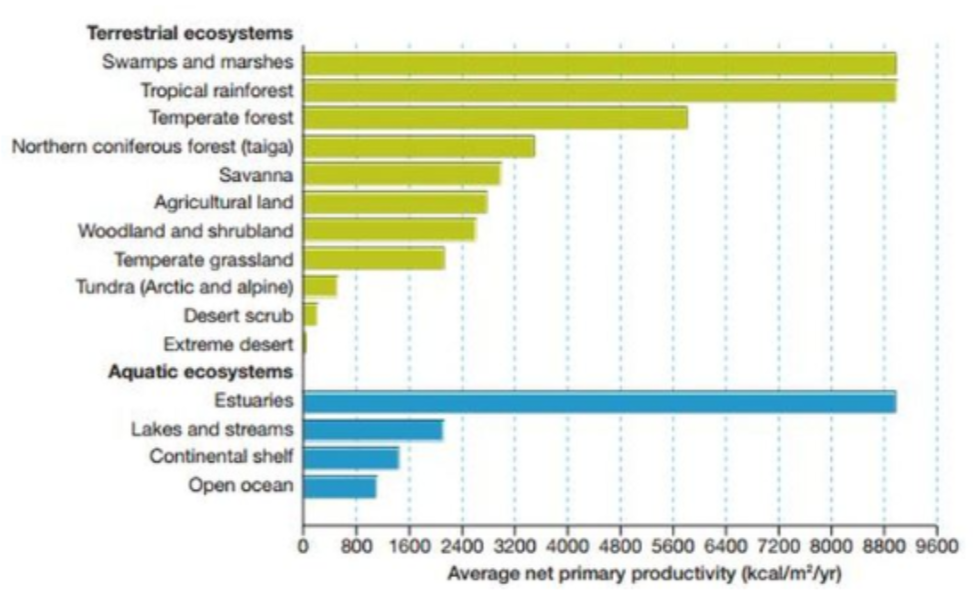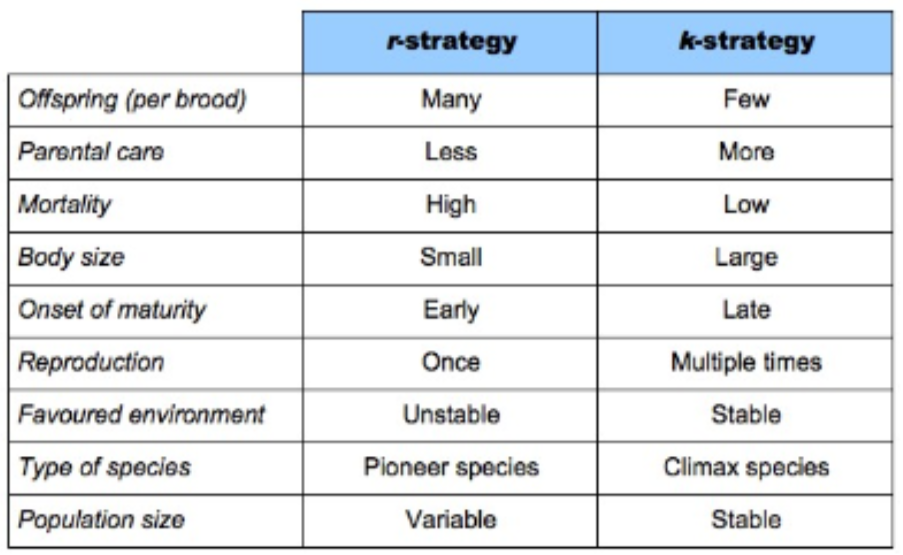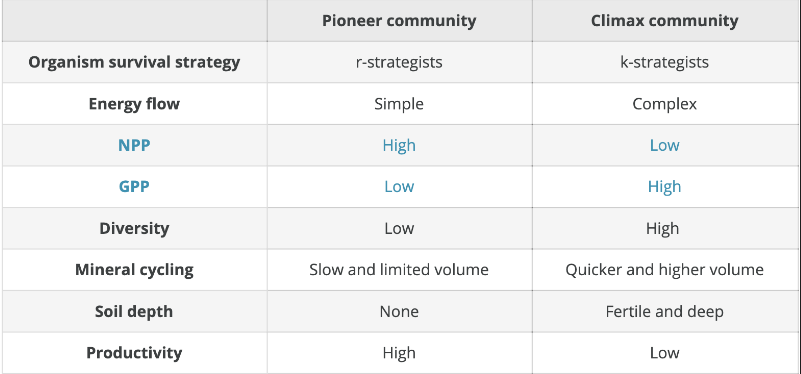2.4: Biomes, Zonation, and Succession
1/49
There's no tags or description
Looks like no tags are added yet.
Name | Mastery | Learn | Test | Matching | Spaced |
|---|
No study sessions yet.
50 Terms
Significant ideas
1) Climate determines the type of biome in a given area, although individual ecosystems may vary due to many local abiotic and biotic factors.
2) Succession leads to climax communities that may vary due to random events and interactions over time. This leads to a pattern of alternative stable steady states for a given ecosystem.
3) Ecosystem stability, succession and biodiversity are intrinsically linked.

Explain how the angle of insolation affects the temperature at different latitudes referring to the diagram.
→as you move away from the equator, you get more moderate climates
→the more direct the angle of sunlight, the more energy, heat, and productivity
→the less direct, the more the radiation is spread out
insolation
the amount of sun’s energy reaching the surface
How does precipitation determine the type of biome?
→measured in mm/m²/year
→the more precipitation a biome has, the more productivity it will have
↑ rain = ↑ productivity
How does temperature determine the type of biome?
→measured in °C
→extremely high or low temp. = lower productivity
→moderate temp. = higher productivity
generally: ↑ temp. = ↑ productivity
How does latitude determine the type of biome?
def: distance north + south from the equator
→as you move away from the equator, it gets colder, which means lower productivity
(distance from equator has inverse relationship w/ productivity)
How does altitude determine the type of biome?
def: height above sea level
→air is less dense, temps are lower, less water availability, soil is less rich, so productivity is lower
How do ocean currents determine the type of biome?
→regulates climates/biomes by distributing water around the globe
→distributes heat from the equator to the poles (increase in productivity)
How do winds determine the type of biome?
→move air masses from one place to the next, affecting daily and seasonal weather
→Warm, moist air converging near the equator causes heavy precipitation → higher productivity
How does rain shadow determine the type of biome?
def: a dry area on the leeward side of a mountainous area
→the mountains block the passage of rain-producing weather systems and cast a “shadow’ of dryness behind them → lower productivity
Identify the 5 major biomes.
Aquatic (freshwater and marine)
Forest (tropical, coniferous, deciduous)
Grassland (tropical, savanna, temperate)
Desert (cold, hot)
Tundra (alpine, arctic)
Tri-cellular model of atmospheric circulation
ITCS = Intertropical convergence zone
Include:
y-axis: pole degrees
equator 0 degreees
polar cell
polar front
ferrel cell
Hadley cell

Trends/similarities/differences between biomes
Desert: warm or hot temps, doesn’t fluctuate, little or no rainfall
grassland: little rain in winter, fair amount in summer (4 seasons)
savanna: steady temps between warm + hot w/ rainy + dry season
rainforest: very little change in temp, a lot of rainfall
deciduous forest: bitter winters, a little more rain than grassland, 4 seasons
tundra: coldest temps, up to 10-15 degrees C in summer, steady rain in summer but pretty low precipation
Limiting factors of aquatic biomes
water absorbs some light → limits photosynthesis
deep oceans = no light
freshwater may freeze in temperate/polar winters
Limiting factors of forest biomes
nutrients in biomass, not soil
high rainfall leeches from nutrients in the soil
Limiting factors of grassland biomes
low precipitation
extreme temps limit productivity
low decomposition → low nutrient cycling
Limiting factors of desert biomes
little precip.
high evaporation
extreme day/night temp differences
photosynthesis limited by lack of H2O
Limiting factors of tundra biomes
short days = less sunlight = decrease in productivity
frozen water in winter and saturated soils post-thaw limit photosynthesis and slow nutrient cycles
productivity of aquatic biomes
coral reefs: high
deep ocean: low
temperate freshwater: moderate
productivity of forest biomes
tropical: high
temperate: high, but lower in fall and winter
productivity of grassland biomes
moderate to low
productivity limited by seasonal extremes, slow nutrient cycles
productivity of desert biomes
low
H2O needed
soils may have good nutrients from nutrient cycling
productivity of tundra biomes
low: short days, low temps
photosynthesis limited
biodiveristy of aquatic biomes
coral reefs: high
deep ocean: low
temperate freshwater: moderate
biodiveristy of forest biomes
tropical: highest on earth
temperate: 2nd highest
biodiveristy of grassland biomes
high
diverse plants, nutrient-rich soils → extensive food webs
biodiveristy of desert biomes
low
extremes of precip. + temp. = not optimal
biodiveristy of tundra biomes
limited
too cold for reptiles, amphibians, and invertebrates (cold-blooded)

Evaluate graph suggest reasons for differences
Biomes w/ warmer weather + higher precip. are more productive. Also, higher nutrient availability →more productivity. Levels of these factors will influence graph
Outline the changes to biomes that are occurring worldwide as a consequence of global climate change; include species movement and limitations.
Increase in mean temps and decreases in precip. means biomes are migrating. Also, evolution is a slow process so they will mostly have to adapt. This means northward migration when possible, or else declining populations. Also some species are moving toward the equator for more precipitation.
→ plants migrate slowly (animals faster)
r-strategist
grow and mature more quickly + produce many small offspring (most don’t make it to adulthood)
K-strategist
slow-growing, produce few, large offspring (more make it to adulthood)
annotate survivorship curve
type I = k-strategists
type II - organisms w/ constant loss
type III = r-strategists

List features of r-strategists and k-strategists:
offspring, parental care, mortality, body size, onset of maturity, reproduction, favored environment, type of species, population size

Define zonation + describe factors that can cause it
def: change in a vegetation community along an envt’l gradient
caused by changes in altitude, depth of water, tidal level, distance from the shore, etc.
→spatial change
How do the temp, precip., solar insolation, soil type, and species interactions lead to zonation in a montane environment?
decreases w/ increase in altitude
moist @ middle altitudes
more intense @ higher altitudes
decomp. = faster in warmer zones (decrease in altitude = increase in fertility)
competition may crowd out some species
grazing may alter plant competition

Explain how a kite diagram measures zonation
graphically shows amount of species in different zones
→width of kite corresponds to how many species there are
→shows # of animals (or % cover for plants) against distancee along transect
→distribution of organisms affected by abiotic factors (ex: cliff into ocean)
define succession
the predictable change in a vegetation community over time
starts with a pioneer community
distinguish between primary and secondary succession
primary - occurs on bare abiotic surfaces. the colonization of newly created/available land by organisms
secondary = occurs when established ecosytem is destroyed
Explain the stages of primary succession
start w/ bare surface
colonization
establishment
competition
stabilization
climax community
define stage 1: colonization
terrain/soil: bare inorganic surface
biota: r-select species/pioneer species: short life cycles, rapid production of new offspring/seeds
define stage 2: establishment
terrain/soil: weathering of rock enriches soil w/ nutrients →decomp. enriches topsoil
biota: invertebrates appear →increase in humus (organic material) + water-holding capacity
define stage 3: competition
soil/terrain: grasses grow, displacing pioneer species
biota: larger plants allow k-selected species to establish themselves →outcompete r-select
define stage 4: stablization
terrain/soil: more soil nutrients allow for shrub growth
biota: fewer new species b/c late colonizers are competitive, complex food web develops, k-selected specialize
define climax community
terrain soil: increase in soil depth allows for growth of trees
biota: steady-state dynamic equilibrium → max possible development
Outline how NPP, GPPP, Diversity, Soil depth, energy flow, and avg. organisms size change throughout succession
avg organism size goes from small to large, and it goes from r-select to k-select
energy flow goes from simple to complex

critical aspects of resilience
threshold, resistance (biodiversity), and precariousness
Why do secondary forests display denser growth and contain species not found in the original primary forest?
No competition, lots of fertilizer sunlight, seeds blowing to new places
Factors that could lead to alternative stable states in an ecosystem
multiple disturbances throughout the stage of secondary succession
Ways in which humans can disrupt process of succession
→ cutting for timber
→clearing for farming
→construction
→forest fires
→overgrazing
→overfishing